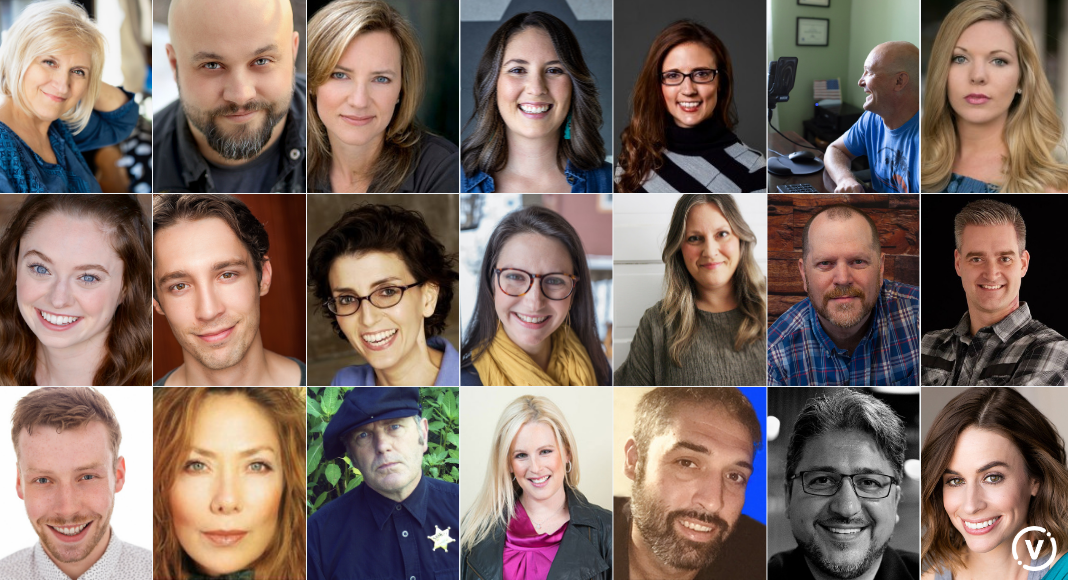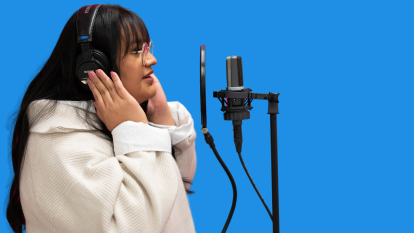 Voice Over
Voice Over
How to Deliver An Authentic and Conversational Read
Month after month, the conversational read continues to top the list of the most requested voice over styles by clients on Voices—and it’s a trend we don’t predict changing anytime soon.
A conversational voice sounds like a real person engaged in everyday conversation with their peers, but achieving a truly conversational read is a lot more challenging than it sounds. How do you sound like you’re deep in conversation and not reading at all when you’re reading directly from a script?
To answer that question, we tapped into the experts, the Voices Insiders. The Voices Insiders are a group of professional voice actors who share their insights with the Voices community every month to help voice actors at every level develop in and grow their careers.
Read on to find insights from the Voices Insiders, including the most common mistakes, what to listen for in your own reads, and steps you can take to get in the right mindset for a conversational read.
What are the most common mistakes voice actors make when trying to deliver a conversational read?
Think back to your last get-together. Who were the people you were naturally drawn to and who were the people who had you wishing you were talking to someone else instead? Chances are, you enjoyed speaking to people who spoke naturally and with varied inflection, and not those who sounded forced or who couldn’t read the room—voice over is no different.
Clients recognize that today’s audiences want to be talked with, and not at, which is why the conversational voice over style has gained popularity in recent years.
To hear real examples of exactly what clients are listening for and to hear examples of what doesn’t quite hit the mark, we recommend listening to this episode of Mission Audition with Andrea Collins:
To help voice actors identify their own areas of improvement, we asked the Voices Insiders to share some of the most common mistakes made when delivering a conversational read. Here’s what they said:
“Over-pronunciation. If you wouldn’t over-pronounce it in a conversation with a family member, don’t do so in your read. Get out of the mindset that since it’s ‘voice over,’ every word has to be clear and precise. It’s ok to run a few words together. Change ‘want to’ into ‘wanna,’ for example. And a word like ‘desktop,’ you don’t have to over pronounce the ‘k.’ It almost becomes ‘dess-top’ in a conversational read. The ‘k’ is pretty much silent. Nothing kills a conversational read faster, in my mind, than over-pronunciation.”
“The ‘trying’ is probably the biggest mistake I’ve made with my conversational reads in the past. Sometimes, if I try too hard to sound conversational, it will come off as forced and stiff-sounding. Take a breath! Watch something funny or do some yoga to relax before recording your conversational read and it will sound more natural.”
“One of the challenges I see is people jumping in without answering the basic questions: who am I? Who am I speaking to, and what am I trying to accomplish? Once you do that, you can start rehearsing and trying a few different approaches. If you don’t rehearse a few times, your chances of getting the gig go way down.”
“Some actors focus on what the delivery ‘should be’ rather than what might come naturally. You have to learn to let go a little which may not sound as ‘smooth’ as what you’re used to or use on other projects that call for a different style.”
“I’ve noticed that I tend to speak too loudly when I first read a spot like this. Most of my first takes are me adjusting my own voice volume manually (not using gain) before I get to the sweet spot of my read.”
“Adding too many noises to try and humanize the read. It starts to feel forced and uncomfortable.”
“Not relaxing. I try to visualize a grandfather sitting at a campfire telling a story. I tend to lean toward a slightly more dramatic style like documentaries and commercials. So, finding that relaxed tone can be challenging for me.”
“‘Blowing off’ all of the content. In actual conversation, we’re not always nonchalant. We assign more importance to some things, less to others. So, a conversational read needs an invested point of view, too.”
“Overly planning the sound or cadence of each sentence, which has the opposite effect and sounds unnatural.”
What are the signs of a great conversational read?
When it comes to a great conversational read, as the saying goes, you’ll know it when you hear it. A great conversational voice over pulls the audience in, making them feel they are being spoken to authentically and directly by someone they know.
We asked the Voices Insiders to put this feeling into their own words. Here’s what they said:
“When listening you feel like you could reply or have the voice over respond directly to you.”
“I think when you immediately feel like you know the person on the other end of the voice over. You say, ‘she sounds just like my friend…’ It sounds like you’re being spoken with, not at.”
“As an audience member, I feel engaged with what the speaker is saying, and I want to hear more of what they have to say.”
“In my opinion, a great conversational read is one that, when listened to, feels like the person is speaking without a script; like it’s just pouring out of them naturally. They’re speaking from experience. You feel like they know and believe what they’re saying.”
“A great conversational read gives me all the ‘feels.’ Happy, sad, relaxed, etc. Conversational reads flow smoothly, without unnatural pauses. They simply *sound* conversational!!”
“Hearing the relaxation in someone’s voice. To me, that is at the heart of every effective conversational read.”
“A great conversational read feels familiar. It’s sitting on the porch chatting with your best friend. It may not be perfectly smooth, but it’s real.”
“A true conversational read will offer a connection and put the listener at ease.”
“If you believe what they say. It’s as simple as that.”
7 Tips to Get into the Mindset for an Authentic and Conversational Read
Now that we’ve covered what makes and breaks a conversational read, here are seven ways to help you get in the mindset for an authentic and conversational vocal performance.
1. Think about your character
Understanding your character, their motivations, and their relationship to the audience is the first building block to delivering a truly authentic and conversational read. Once you understand their raison d’être and can find some common ground, you’ll find a believable vocal performance will come much more naturally.
“Think about character first. Who are you and to whom are you speaking? It’s not a read, it’s a performance, and you’re not an announcer, you’re an actor.”
2. Picture your audience
No matter what your home studio setup is like, being alone in a tight space can make it tough to sound natural. That’s where your imagination can step in. Try to picture your audience, whether it’s a friend or a loved one, or someone you’ve imagined is your target audience, and pretend you’re speaking directly to them.
If you’re not feeling imaginative, another alternative is to try a quick FaceTime with a friend to put you in the conversational mood before you hit record.
“I almost always picture my brother as the audience and ask myself, ‘how would I talk to him about this?’ He knows me well and can tell when I’m not being genuine. As I listen to myself record or when I’m editing a take, I ask, ‘would he look at me weird if I was talking to him like this? Or would he think we’re just having a normal conversation?’ If he’d have a raised eyebrow, I usually go back and rerecord until I feel like it’s a natural read that would pass the ‘brother’ test.”
“When I was starting out in radio, one of the best tips I received was to bring a picture of someone you know tape it to the wall, and present the material as if you are telling that person about the content you’re reading.”
“When I need to get conversational with my read, I picture myself having an actual conversation with a friend and I read the script as if I’m telling that friend about whatever idea or product is in the script. I ALWAYS take a listen to what I’ve recorded afterward because inevitably I don’t sound very conversational at first! It’s also worthwhile going through the script before you record and finding the little moments in the script where you can add a bit of humanity, whether it’s a natural pause, a change in pitch, or speed.”
“I think about who I’m talking to specifically. Someone I actually know. Someone who would call me out on it if I started talking to them in any way other than a conversational tone.”
“Talk to just one person, and make it a person you know! It could be your best friend, your partner, your brother-in-law, whichever one person will give you the right mindset to make a real, personal connection with your voice.”
3. Act with your full body
Your voice is the star of your vocal performance, but your body language plays an important role, too. If you can, stand up! Don’t be afraid to move your arms and talk with your hands—whatever comes naturally to you.
“For a job that requires a warm, genuine ‘real person’ sound, try smiling when reading. Let your face go as expressive as it needs to!”
“You’re acting! Use your body. Stand up and gesture. Make faces. Whatever can get you into character.”
4. Take a running head start
If it takes a sentence or two to find your conversational groove after you press record, don’t get discouraged. Instead, embrace it by taking a running head start. Set the stage for your conversational read by describing aloud what you’re about to speak to in a few sentences, or try these tips from the Voices Insiders.
“I really try to focus on who the intended audience is, and it’s especially helpful to imagine someone I know who fits the bill. Then, I lead into the read with an improvised conversation that flows naturally into the copy. Otherwise, I always feel like I’m blurting out those first few words.”
“A lead-in line. You have to imagine a situation where the first line makes sense in reply to a question from someone. I always try and figure out a lead-in that asks a specific question that the first line of the script then goes on to answer. And take your time figuring out the situation so it makes sense. Are you talking to one person or a group of people?”
5. Add pauses and use natural language where you can
Regular everyday conversation isn’t perfect. It’s filled with pauses, missteps, and colloquial language. Before you begin your read, take note of where you would naturally take a pause in your regular conversations or lose consonants and bring this authenticity into your performance.
Note: Ensure you are following the creative direction laid out by your client and consider providing more than one take.
“Adding pauses or stretching a word while you imagine you are thinking of the next word to say. We don’t have conversations in perfect English. We need time for our brains to process what we are trying to say. Knowing how to vocalize those pauses can really make a read sound natural.”
“Don’t be afraid to ad-lib if the script allows for it. I have found that my successful conversational reads are the ones where I let loose and let personality come through a bit. However, be careful not to make your read so full of personality that it distracts from the message. Just have fun and that will ultimately come through in your reads!”
“Add contractions. If you see a ‘you have,’ or an ‘it is,’ or ‘will not,’ don’t be afraid to ‘contract’ ‘em up! Changing it to ‘you’ve,’ or ‘it’s,’ or ‘won’t’ is going to sound way more natural. Don’t be afraid to throw in the odd ad-lib too! “
6. Speak with an ‘indoor voice’
Loud, booming voices are typically associated with an announcer-style read, and not a natural or conversational style. If you find your vocal performance sounds more at home in a noisy arena than in a close conversation, try lowering your voice.
“I try to intentionally speak with ‘an indoor voice’. Lowering your voice’s volume manually (I’m not talking about gain here) really helps get you in the mindset of speaking more naturally or conversationally.”
“I come from a news anchor background so I had to retrain my brain to lose the ‘authority’ tone, when needed, and be real and conversational. I get a little closer to the microphone and I pretend that my computer monitor is a person. That way, I am speaking at the same volume that I would use if I were sitting on the porch next to a friend having a conversation.”
7. Practice!
Mastering the authentic and conversational read doesn’t usually come naturally—it takes practice.
To get familiar with how your voice sounds and to identify your problem areas, try reading aloud and recording your voice. You may also want to consider working with a voice over coach to help improve your vocal performance and grow your skillset. No matter which path you take, be sure to regularly devote time in your schedule to practice your craft and get comfortable speaking and acting from text. Keep in mind: your level of comfort will come across in your reads.
Find a variety of voice over sample scripts on the Voices blog to practice with or visit our Coaches Directory to find a coach who suits your unique needs.
“Practice! Read aloud newspapers, articles, books, anything! It will definitely help.”
“I always read the copy out loud at least once beforehand so I can find any troublesome areas or tongue twisters. I also look up any terms I’m not familiar with. It’s hard to be conversational if you’re using terms you don’t understand!”
Put your conversational vocal style to work
Ready to grow your voice over career and start auditioning? On Voices, there are thousands of clients searching for the right voice for their projects. Sign up today for a Voices account and audition for voice acting jobs in a range of categories, roles, and styles, including the conversational read.



Leave a Reply